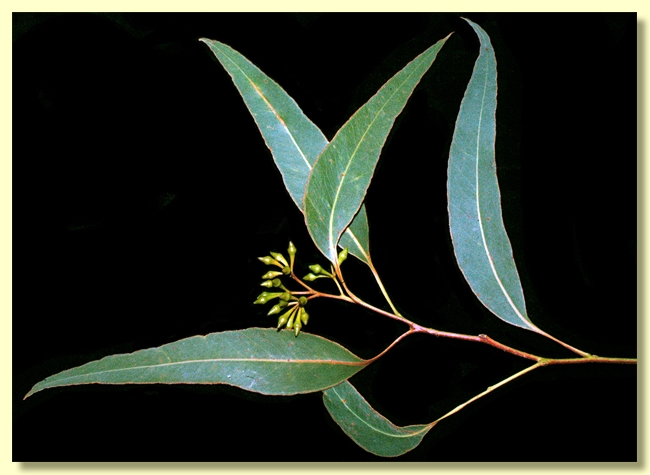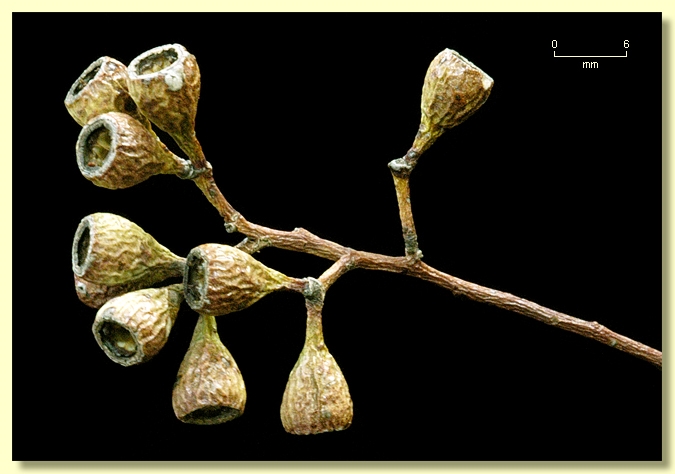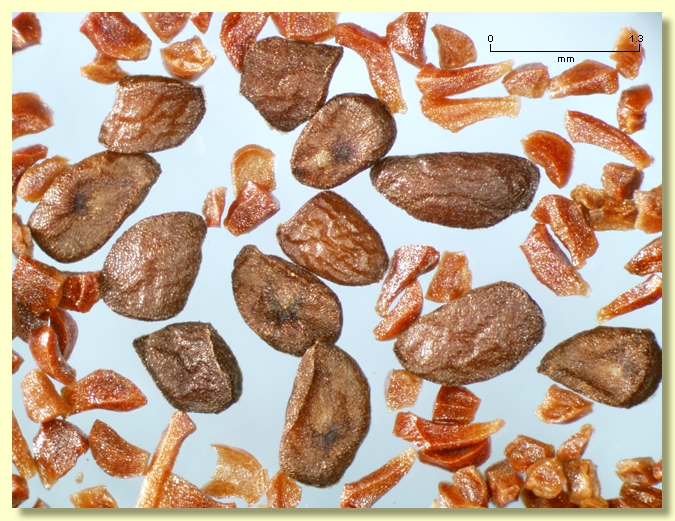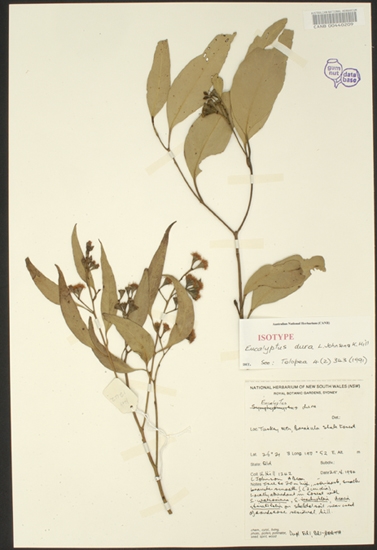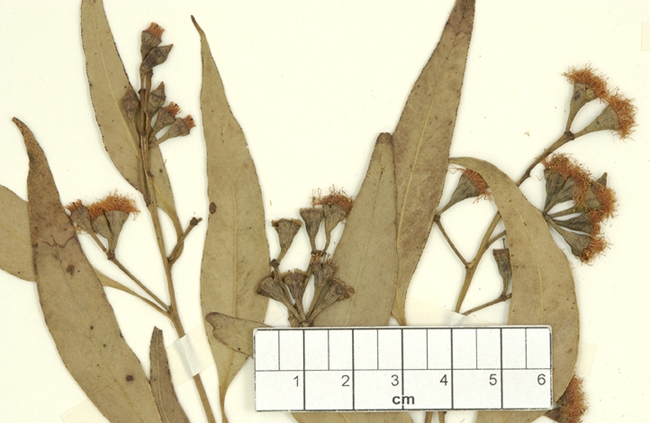Eucalyptus | Symphyomyrtus | Adnataria | Terminales | Rhodoxylon | Concolores
Euclid - Online edition
Eucalyptus dura
Tree to 25 m tall. Forming a lignotuber.
Ironbark, dark grey to black. Branches ca 3 cm diameter or narrower often smooth-barked.
Oil glands sometimes present in the pith of the branchlets.
Juvenile growth (coppice or field seedlings to 50 cm): stem square in cross-section; juvenile leaves opposite only at lowest node, then becoming alternate, petiolate, lanceolate to broadly lanceolate or ovate, 9.5–14 cm long, 2–4 cm wide, base tapering, apex pointed, glossy green, concolorous.
Adult leaves alternate, petiole (1)1.5–3(3.5) cm long; blade lanceolate, sometimes falcate, 9–18 cm long, 1.5–3.3 cm wide, base tapering to petiole, concolorous to slightly discolorous, normally glossy, green, rarely dull, side-veins usually at an angle less than 45° to the midrib, sometimes slightly greater than 45° to midrib, densely to very densely reticulate, intramarginal vein parallel to and well removed from the margin, oil glands usually sparse and intersectional, or absent.
Inflorescence terminal compound, or axillary compound, peduncles 0.7–2.5 cm long, buds 7 per umbel, pedicels 0.4–0.8 cm long. Mature buds obovoid to pyriform, 0.7–0.9 cm long, 0.4–0.5 cm wide, rarely ovoid, sometimes angled on the lower part of the hypanthium, scar present, operculum conical to rarely slightly beaked and narrower and much shorter than the hypanthium, stamens inflexed, with outer staminodes, anthers adnate, positioned obliquely at filament tip, cuboid, dehiscing by terminal pores, style long, stigma pin-head, locules 4 or 5, the placentae each with 4 vertical ovule rows. Flowers white.
Fruit pedicellate (pedicels 0.2–1 cm long), usually obconical, sometimes ± barrel-shaped, 0.6–1 cm long, 0.5–0.7 cm wide, disc descending, valves 4 or 5, enclosed.
Seeds brown, 1–2 mm long, flattened-ovoid, shallowly reticulate, hilum ventral.
Cultivated seedlings (measured at ca node 10): cotyledons reniform to oblong; stems square in cross-section; leaves always petiolate, opposite for ca 3 to 5 nodes then alternate, lanceolate to broadly lanceolate to ovate, 7–15 cm long, 3–6 cm wide, base tapering, glossy green.
Flowering has been recorded in April, May, June and August.
A small to medium-sized ironbark tree of south-east Queensland, preferring the higher ground from Boonah north through Ipswich and the D'Aguilar Range, through Yarraman and Proston as far north as the Mundubbera and Biggenden area, then south-west through Manar and Brovinia to the Barakula area. Characterised by the concolorous to slightly discolorous glossy green adult leaves, terminal inflorescences, buds with staminodes and relatively long narrow obconical fruit with four or five valves.
Within its subgroup, E. dura is closest to E. fusiformis, E. ancophila, E. melanoleuca, E. corynodes and E. tetrapleura. All have ovate to broadly lanceolate to lanceolate juvenile leaves. E. fusiformis differs only marginally by having dull adult leaves and ± barrel-shaped fruit (E. durawith glossy to semi-glossy adult leaves and ± funnel-shaped fruit). E. ancophila differs only marginally by having slightly longer adult leaves and slightly shorter fruit. E. melanoleuca differs by having shorter ovate juvenile leaves. E. corynodes differs by having glaucous to blue-grey adult leaves. E. tetrapleura has larger distinctly four-sided buds and fruit.
Eucalyptus suffulgens, E. panda, E. beyeri, E. virens and E. sicilifolia, other members of the sub-group, differ by having much narrower lanceolate to linear juvenile leaves (lanceolate to broadly lanceolate to ovate in E. dura). The two subspecies in E. caleyi both have dull glaucous adult leaves. E. caleyi subsp. ovendenii differs further by having distinctly four-sided buds and fruit.
Within its area of occurrence there are other ironbarks which may be confused with E. dura. They are E. beaniana, E. crebra, E. decorticans, E. fibrosa subsp. fibrosa, E. melanophloia, E. rhombica, E. siderophloia and E. taurina, all of which differ in having buds with stamens all fertile and irregularly flexed.
Eucalyptus sideroxylon differs by having buds that hold the outer operculum into maturity and both the inner and outer operculum shed together at anthesis (no operculum scar).
MORE ABOUT IRONBARKS
Eucalyptus dura: Latin durus, hard, referring to the bark.




